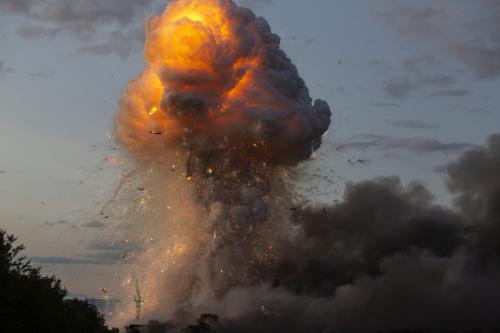In considering U.S. policy options in Syria, policymakers and commentators regularly argue that third-party interventions in civil wars rarely, if ever, succeed. Yet this view is not supported by evidence. An in-depth examination of the literature of civil wars shows that about 20 percent have ended as a result of third-party intervention, typically bringing an end to the fighting far earlier than would otherwise have been the case. The success rate is even higher—approximately 40 percent—for civil wars in the last 20 years.
As the conflict in Syria has claimed more than 250,000 lives and spilled into neighboring states—and now Europe—the United States should create an opposition army capable of stabilizing the conflict and, ultimately, producing a negotiated peace.
Step-by-step
- As I outlined last year in a Brookings analysis paper, U.S. intervention to end the civil war in Syria would require three basic steps:
- First, the United States would need to create a military stalemate on the ground. Historically, this has been achieved either by occupying the country, like the United States did in Iraq, or by building a force that can win on the battlefield and then reining in that force.
- Second, we would need to help create a power-sharing agreement that reflects the real demographic weights of the warring parties, including guarantees for minority groups.
- Third, that power-sharing agreement must be accompanied by long-term guarantees to ensure it will hold. Creating a conventional force, with heavy American complement, that can ultimately act as a legitimate state institution in post-war Syria could serve as this guarantor.
Americans tend to fixate on the first step as the biggest hindrance to successful intervention. However, this first step is the easiest. A successful military intervention is straightforward—if we do it right and commit the needed resources. In Iraq, for instance, many commentators said it would take ten years to stabilize Iraq. Yet, the U.S. surge, working with Sunni tribes, achieved its goals within 12 to 18 months. This quick stabilization is the historic norm.
The hardest step, by far, is the third: making and keeping long-term guarantees. In the past, that’s where the United States has screwed up, walking away prematurely as we did in drawing down from Iraq in 2011.
Strong enough
What does this mean for U.S. strategy in Syria? I have proposed that we build a new Syrian opposition army. It would need to be a large, conventional force and would need to be built outside of Syria. Claims that the United States cannot build another country’s army are nonsense.
While America certainly can’t build an army equivalent to its own, that’s hardly necessary in Syria: all of the warring factions in Syria have armies that are at best mediocre, but more often outright terrible. The armies of Bashar Assad and the Nusra Front, an al-Qaida affiliate in Syria, are abysmal. The Islamic State’s military capabilities have an outsized reputation, as closer study of their tactical capabilities has shown. The U.S.-built force would only need to be strong enough that, buttressed by U.S. airpower, special operations, and intelligence support, it could defeat the other factions in the country.
This plan closely resembles the one that General Martin Dempsey, then Chairman of the Joint Chiefs of Staff, proposed in 2014. The Obama administration has since walked away from the idea. This was a mistake.
The political role of a new Syrian army
While building a Syrian opposition force is critical to the long-term success of U.S. intervention in Syria, the United States will also have to deal with the political situation. This means creating a conventional force capable of occupying territory, creating safe spaces within that territory, and demonstrating that it can care for a population.
This was a crucial U.S. failure in Iraq, allowing then-Prime Minister Nouri al-Maliki to politicize the Iraqi forces when U.S. troops pulled out. The United States must create a force and help it develop into an institution that can serve as a strong, independent, and apolitical guarantor in post-conflict Syria and that can avoid becoming the cat’s paw of a future dictator.
In the end, there are no good policy options for Syria. The administration’s self-defeating and nonsensical focus on the Islamic State, rather than on the larger drivers of the region’s civil wars, leaves us with only sub-optimal choices. It is imperative that we use the lessons of the past civil wars to guide our actions in the present. My proposal is not a quick, easy, or cheap option. It requires investment and long-term commitment. Yet, if you want to pursue a path that leads to a return to stability in Syria and the region, it is necessary.
The Brookings Institution is committed to quality, independence, and impact.
We are supported by a diverse array of funders. In line with our values and policies, each Brookings publication represents the sole views of its author(s).



Commentary
Building an army for Syria’s future
November 17, 2015